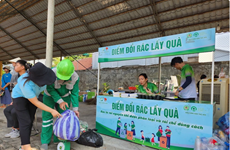Vietnam’s air emission standard stands low
Standards on emission concentration in Vietnam are below international standards.More pollutants in Vietnam, therefore, can be emitted than in other countries.
 Motorbike riders in Hà Nội have to wear masks on a dusty highway section through Cau Dien - Nhon (Photo: VNA)
Motorbike riders in Hà Nội have to wear masks on a dusty highway section through Cau Dien - Nhon (Photo: VNA)Hanoi (VNA) - Standards on emission concentration in Vietnam are below
international standards. More pollutants in Vietnam, therefore, can be emitted than in other countries.
Nguy Thi Khanh, Green Innovation and Development Centre (GreenID) executive director in Hanoi, told a panel discussion on air quality held by the US Embassy on May 3.
According to statistics provided by Green ID, Vietnamese standards on PM10 (inhalable particles with diameters of generally 10 micrometres or smaller) per day are 150 micrograms per cubic metre compared with only 50 micrograms per cubic metre recommended by the World Health Organisation (WHO).
Vietnamese standards on PM2.5 (fine inhalable particles with diameters of generally 2.5 micrometres or smaller) are 50 micrograms per cubic metre. The WHO figure is 25 micrograms per cubic metre.
Khanh said that Vietnam’s limit is four times higher than China’s.
According to the US Embassy in Hanoi, the average PM2.5 concentration in the first quarter of this year reached 54.6 micrograms per cubic metre, compared to 50.5 micrograms per cubic metre last year.
On 37 out of 90 days in the first quarter the national limit of 50 micrograms per cubic metre was exceeded. On 78 days, the data violated WHO guidelines. Air pollution in Hanoi reached its peak with 234 micrograms per cubic metre at 11 am on February 15.
The monitoring results were based on an air quality monitor on the roof of the US Embassy in Hanoi at 7 Lang Ha street, installed in April 2015.
The hourly PM2.5 concentrations are then converted into the US Environmental Protection Agency’s Air Quality Index (AQI) made available to the public on airnow.gov.
In 2016, the average AQI was 121. In the first three months of this year, it has risen to 123. Both indexes are regarded as unhealthy for sensitive groups.
However, according to the embassy, there are several factors that could lead to a difference between the US Embassy’s data and the Vietnamese Government’s.
Firstly, air quality differs through the city, for example, there is a 7.2 kilometre between US Embassy’s equipment and the monitors operated by the Centre for Environmental Monitoring. Second, the methods of calculating AQI and pollutants may differ. Third, there may be differences in site, operations, and maintenance procedures. These factors make comparisons difficult.
Research from Green ID also showed that sources of air pollution in Vietnam come from vehicles, construction, burning waste, cooking, transboundary pollutants and coal power plants, a major contributor.
Nguyen Thi Anh Thu, researcher and head of air quality at Green ID, said that a 1,200 megawatt coal plant per year emits more than 17,000 tonnes of lead, over 1,600 tonnes of mercury, over 26,000 tonnes of particulars, among other emissions.
In 2016, there were 26 active coal power plants nationwide with capacity of 13,000 megawatts. The number is expected to surge to 67 plants with total capacity of 55,300 megawatts by 2030.
During the panel discussion, Green ID also reintroduced a study on Vietnamese public concern on air quality which was published in January this year. It interviewed 1,400 participants, nearly 90 percent of whom are Vietnamese and under 40 years old.
Some 48 percent of the interviewed did not know the definition of AQI, but 80 percent were very concerned about air quality. More than 53 percent were dissatisfied with local air quality.
Jason McInerney, Chief of the US Embassy’s Environment, Science, Technology & Health Unit said that from US experience, awareness is important to improving air quality.
He said that the US held exchanges between EPA and Centre for Environmental Monitoring under Ministry of Natural Resources and Environment (MONRE) and stepped up technical discussion between experts.
“We will continue working with MONRE to shape Vietnam’s environmental law going forward,” he said.
Khanh from Green ID said that Vietnam needs a clean air law.
The implementation of the Environmental Protection Law 2014 has been limited. Also, mechanisms to control air pollution across borders haven’t been developed. This requires cooperation between countries in the region and long-term plans from the government, she said.-VNA
Nguy Thi Khanh, Green Innovation and Development Centre (GreenID) executive director in Hanoi, told a panel discussion on air quality held by the US Embassy on May 3.
According to statistics provided by Green ID, Vietnamese standards on PM10 (inhalable particles with diameters of generally 10 micrometres or smaller) per day are 150 micrograms per cubic metre compared with only 50 micrograms per cubic metre recommended by the World Health Organisation (WHO).
Vietnamese standards on PM2.5 (fine inhalable particles with diameters of generally 2.5 micrometres or smaller) are 50 micrograms per cubic metre. The WHO figure is 25 micrograms per cubic metre.
Khanh said that Vietnam’s limit is four times higher than China’s.
According to the US Embassy in Hanoi, the average PM2.5 concentration in the first quarter of this year reached 54.6 micrograms per cubic metre, compared to 50.5 micrograms per cubic metre last year.
On 37 out of 90 days in the first quarter the national limit of 50 micrograms per cubic metre was exceeded. On 78 days, the data violated WHO guidelines. Air pollution in Hanoi reached its peak with 234 micrograms per cubic metre at 11 am on February 15.
The monitoring results were based on an air quality monitor on the roof of the US Embassy in Hanoi at 7 Lang Ha street, installed in April 2015.
The hourly PM2.5 concentrations are then converted into the US Environmental Protection Agency’s Air Quality Index (AQI) made available to the public on airnow.gov.
In 2016, the average AQI was 121. In the first three months of this year, it has risen to 123. Both indexes are regarded as unhealthy for sensitive groups.
However, according to the embassy, there are several factors that could lead to a difference between the US Embassy’s data and the Vietnamese Government’s.
Firstly, air quality differs through the city, for example, there is a 7.2 kilometre between US Embassy’s equipment and the monitors operated by the Centre for Environmental Monitoring. Second, the methods of calculating AQI and pollutants may differ. Third, there may be differences in site, operations, and maintenance procedures. These factors make comparisons difficult.
Research from Green ID also showed that sources of air pollution in Vietnam come from vehicles, construction, burning waste, cooking, transboundary pollutants and coal power plants, a major contributor.
Nguyen Thi Anh Thu, researcher and head of air quality at Green ID, said that a 1,200 megawatt coal plant per year emits more than 17,000 tonnes of lead, over 1,600 tonnes of mercury, over 26,000 tonnes of particulars, among other emissions.
In 2016, there were 26 active coal power plants nationwide with capacity of 13,000 megawatts. The number is expected to surge to 67 plants with total capacity of 55,300 megawatts by 2030.
During the panel discussion, Green ID also reintroduced a study on Vietnamese public concern on air quality which was published in January this year. It interviewed 1,400 participants, nearly 90 percent of whom are Vietnamese and under 40 years old.
Some 48 percent of the interviewed did not know the definition of AQI, but 80 percent were very concerned about air quality. More than 53 percent were dissatisfied with local air quality.
Jason McInerney, Chief of the US Embassy’s Environment, Science, Technology & Health Unit said that from US experience, awareness is important to improving air quality.
He said that the US held exchanges between EPA and Centre for Environmental Monitoring under Ministry of Natural Resources and Environment (MONRE) and stepped up technical discussion between experts.
“We will continue working with MONRE to shape Vietnam’s environmental law going forward,” he said.
Khanh from Green ID said that Vietnam needs a clean air law.
The implementation of the Environmental Protection Law 2014 has been limited. Also, mechanisms to control air pollution across borders haven’t been developed. This requires cooperation between countries in the region and long-term plans from the government, she said.-VNA













